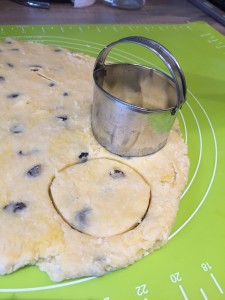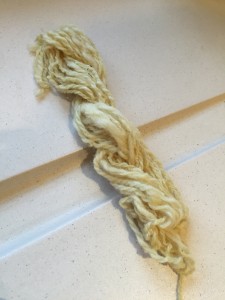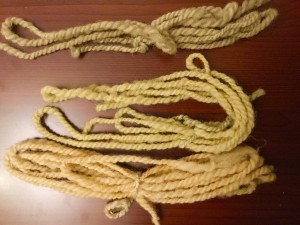It’s St. David’s day, the day commemorating Wales’ patron saint. It’s a day for daffodils and making welsh cakes, which are a sort of scone/pancake hybrid and delicious.
Today I embarked on some St David’s day-inspired craft activities–dyeing with daffodils and heather–and made a batch of Welsh cakes. The cakes are all but eaten and I have some dye results to share.
I was inspired by an article in YarnMaker to use daffodils as dye stuff. The sample in the article was a lot more yellow than what I’ve been able to achieve. However, I’m sure if I used more flowers I would have gotten a stronger colour. Still I like this pale yellow.
 Here in England the daffodils have been out for a few weeks and there are many more to come. Anyone who has waited all winter to get out and gather some fresh dye stuff, daffodils are a great place to start I used 6-8 small blossoms for the dye stock and mordanted my Norfolk Horn yarn with alum and cream of tartar. The dye stock was a vivid yellow but it took quite some time for the colour to strike. I’m going to try this again with a greater quantity of flowers.
Here in England the daffodils have been out for a few weeks and there are many more to come. Anyone who has waited all winter to get out and gather some fresh dye stuff, daffodils are a great place to start I used 6-8 small blossoms for the dye stock and mordanted my Norfolk Horn yarn with alum and cream of tartar. The dye stock was a vivid yellow but it took quite some time for the colour to strike. I’m going to try this again with a greater quantity of flowers.
Winter-flowering heather is a hearty if tiny blossom that gives orange/brown to grey and brown/grey colours. It’s another option for those looking for fresh dye stuff in the winter months. Heather is associated more with Scotland than Wales, but I’ve used some handspun Llanwenog to keep the Welsh theme going.
I used a few handfuls of white heather blossoms in my dye pot and after awhile a orange/brown colour appeared.
The first sample (bottom) here is with the alum/cream of tartar mordant which to my eye has made a light rusty brown. (It’s not easy to see in the photo).
The second sample (middle) was from the same dyepot to which I added copper sulphate as a modifier. To me this sample is somewhere between a yellow, a pale green and a brown, depending on the light and what colours it sits next to. It doesn’t look like much, but I love it’s subtlety.
The final sample (top) is again from the same dyepot with iron added as a modifier. I see a pale blue/grey. I love how these three sample look together. I can envision using this palette in a weaving project or perhaps a sweater or wrap.
Spring time is still a few weeks away, but more dyestuff is popping out of the hedgerows and flower beds everyday. It’s been warm here and I’ve seen gorse for a few weeks now and the first broom flowers have started to appear. Gorse gives a yellow and its smell is unbelievable–think pineapples and coconut. Broom should also give yellow with alum and a green with copper.
Warm weather means that sunny spots other flowers are growing. Keep your eyes open for calendula. There’s also leftovers to gather. I pocketed a few handfuls of Mahonia berries the other day. Allegedly they give some colour. There are also ivy berries and acorns.




As you’ve said, gathering dyestuffs out your own back door is one of the most satisfying aspects of natural dyeing.
My daffodils come up spottily and sporadically, but I’ve been drying them and saving them up until I have enough for a nice dye bath…at least that was the plan until the deer started eating them. Attention Deer: You are not supposed to be eating the daffodils! You already eat everything else!!
Do you think if I made them some Welsh cakes they’d leave the flowers alone? Probably not.
I read a hot tip today about discouraging mice from eating your freshly sown peas–plant some prickly holly leaves with them. That won’t work with deer though.
You are so right about the fun in collecting your own dyestuff. It gets me ridiculously excited. If and when I get my act together and split my massive rhubarb plant, that could be one of my next projects. Having said that, I found some eucalyptus! Apparently it works best when dried.
I think you get different colors with the eucalyptus depending on whether it’s fresh or dried, so maybe you should try it both ways.